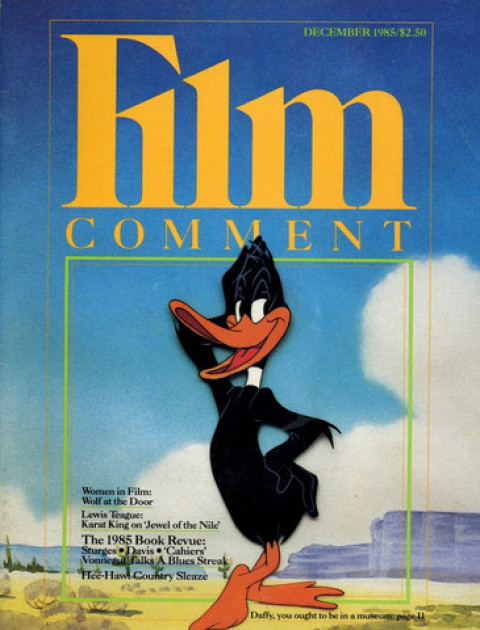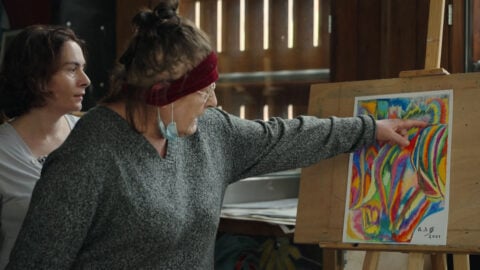
No matter what it gets, it never gets easier. Making movies is nearly impossible when you’re young enough to handle the heartbreak and the compromise; and, as shown in John Boorman’s Money Into Light; The Emerald Forest, A Diary (Faber and Faber, London, 1985, £ 4.95), getting older doesn’t necessarily give you an edge. Neither, it turns out, does making a few of the best movies of the past couple of decades. Point Blank; Deliverance; Excalibur. Those last two even turned a tidy profit. Great movies, solid money: good enough. Give the man what he wants.
It doesn’t happen that way, of course, a state of affairs to which this diary of the making of The Emerald Forest bears eloquent, bemused, and sometimes tattered witness. Everyone talks a lot about track record in Hollywood, but winners have to run the full course every time out. Even the Mafia respects past achievement more than movie town. You can make your bones in the mob, and earn a workable—if not always livable—annuity of position and respect. In Hollywood, the sands are always shifting, and often getting washed right out to sea, like the vanishing Malibu coastline Boorman writes about. Forget about making bones. Making a major studio movie, each time out, is more like digging your own grave.
Boorman has almost buried himself a few times. Leo the Last. Zardoz. Hell in the Pacific. Exorcist II: The Heretic. He manages, however, to pull himself up out of the pit and, smudged and rumpled, to start all over again. He reaches long for a theme, and his grip is sometimes shaky, but even if he can’t bring off everything he wants to, he can always bring his audience with him on a headlong journey of discovery. Every frame he shoots is vibrant. He cuts with unexcelled dynamism; the scenes of shooting the rapids in Deliverance are sensory immersions and metaphysical baptisms. His movies are odd, unexpected adventures. Even if they seem to be lofted out of some perpetual left field, they are all central, indeed vital, to contemporary film. His movies are different; he is a director who can, and has, made a difference.

All this edging up to putting Boorman in position has another side. Money Into Light is not quite the book you would expect a great director to write. It is shrewd and witty and sometimes impassioned, but it is a producer’s log more than a collection of director’s reflections.
To be sure, some of the reflections are quite vivid. Describing how he got “a sudden, electrifying charge” in a Deliverance scene, and recalling that Samuel Fuller once called such moments “the one thing,” Boorman tells Jon Voight, “When you say that line, look over your left shoulder.” Voight, along with Ned Beatty and Burt Reynolds, is clinging to a rock in a ravaging river, but still wants to know, “Why would I do that?” Boorman vamps. “You hear something. You are alert to everything.” In fact, as Boorman says, the head turn gave “the composition a tremendous power, the eye went to Voight and the power was transferred to him.” Boorman’s account makes the genesis of the moment sound slightly mystical and eminently practical, but its electric impact onscreen may defy any analysis, even the director’s. It is closer to the kind of visceral magic Boorman imputes to Takuma, shaman of the Kamaira Indians in the depths of the Amazon, who told the adventuring auteur, “You make visions, magic. You are a paje like me.”
This sounds—and, in the book, seems—somewhat pat. This is no reason to doubt that the line was delivered as rendered, but to an outsider it has the ring of a con job. A bit of a cuff, a snatch of a compliment, both at once. Boorman seems flattered at the comparison, whose subtext, in fact, may be as apt as its rather romantic surface. Directors, like tribal magicians, are good at tricks, illusions, spiritual cajolery, mysticism, and confidences, the secret as well as the tricky kind. Later, a documentary filmmaker, Adrian Cowell, warns Boorman that “Takuma is dangerous. He [Cowell] learned to hunt with him… and has since seen many manifestations of his power.” None of these manifestations is recorded, but Money Into Light is dedicated to Takuma.

There are signs everywhere in this book of more temporal kinds of power, however. For every line about the applied art of filmmaking, there are pages on the hardships of deal making. For every travel diarist’s entry of ancient wonders, there are perhaps twice as many tales of hard-fought battles with perfidious backers. For every pre-production hassle on Emerald Forest, there is a matching story of workaday madness on a previous production.
Well into the shooting, and about two weeks behind schedule, Boorman writes, “Apart from the lack of time, I find I have no stomach or heart for this journal. Powers Boothe had “suddenly seized up in a scene under a waterfall,” and must be rescued by Charley Boorman, the director’s son who was also starring in the film, and three crew members; shortly before, the wife and two daughters of one of the makeup men, on a visit from England, had been gravely injured in a car accident en route from Rio. Such intimations of mortality, inevitable in such a life-encompassing undertaking as a film shoot, only shadow the more immediately weighty concerns of schedule and budget. Further details of the shooting are skimmed and scrimped. Near the end of the book, Boorman simply writes, “I have neglected this journal for the last seven weeks, too tired to turn my mind to it.” He does, however, finish the film on time. The rest of the book rounds out briskly in a mellow glow of fatigue and satisfaction, which lasts even through some shaky, sneaks of the film. Problems are carpentered and mostly repaired. Boorman seems pretty well satisfied.
The Emerald Forest has, subsequent to Boorman’s journal, done very nicely with press and public alike, but the book could make anyone balk at the effort. Boorman is a very graceful raconteur, and episodes such as the making of Hell in the Pacific have the informality and occasional true hilarity of after-dinner war stories directors like a swap, just as the meetings with financiers and executives are summoned up like so many cautionary tales for the next guy through the door. Goldcrest, the tony British production company responsible for Chariots of Fire, backs off financing The Emerald Forest almost as shooting is about to begin. Boorman reckons that two of his cronies, “Dickie” Attenborough and David Puttnam, have deep-sixed the film by voting against it at a board meeting. Such casual perfidy involves the real threat of cancellation, some hectic last minute negotiating, and finally an agreement with Embassy Pictures that keeps the pressure on Boorman until the film is completed.

It is not only moneymen who come off as uneasy and untrustworthy allies in these pages. Boorman’s old friend and frequent collaborator, the scenarist maudit Rospo Pallenberg, after laboring long on innumerable drafts and weathering, at one remove, all the production uncertainties, tells the director that the casting of Charley is “a disastrous mistake…and that if I could not see it, I was either a fool or a psychotic.” In order to “save [Boorman] from myself,” Pallenberg promises to tell Jerry Perenchio, head of Embassy, these same views, and to recommend that the film not be made. “Let Rospo do his worst,” writes Boorman, with what, considering the circumstances, seems unnatural equanimity. “I have reached the point where I am ready to go home and forget the whole thing. I will do it as I see it, or not at all.”
And so it is done. No postscript on the relationship with Pallenberg, but reading these words, even in retrospect, can anyone believe Boorman was really ready to pack it all in? A natural outrage that an artist of Boorman’s gifts is made to run this gauntlet of dim and double-dealing is tempered by an awareness of strength that grows as the book goes on. It isn’t just that Boorman has steeled himself for survival in the business. He not only does what he has to do to get the movie on, but seems to get off of it. He prevails throughout, as this is not simply a question of getting satisfaction from being right; it is, as much, a matter of enjoying the survival training, of laughing it off even as he goes to the head of the class.
Boorman is a romantic, even when he allows himself a descent into melancholy. Shooting a special effects sequence back in England, he visits the seaside resort of Skegnes, and is reminded of Orwell and Wigan Pier. “Skeggy” is bleak, windblown. It is garish and sad…a place of surpassing ugliness. [The] holiday-makers look like the undernourished slum dwellers of the early Industrial Revolution…. I looked at my fellow countrymen and felt alien. I could find nothing in D.H. Lawrence, not even in J.B. Priestley, to help link me to them…. There is no grace or dignity in these people, no harmony in their dress, no art in their play. Here is a tribe gone sadly wrong, mutated…. When Takuma looked at me, he must have seen what I see now.”

The Indians, even at their most extreme, come off a good deal better. Describing a real kidnapping in Adrian Cowell’s documentary The Decade of Destruction, Boorman writes that Indians, on a revenge raid, “killed two youths and abducted their seven-year-old brother…. It eventually transpired that the Indians had killed the boy shortly after taking him. He kept them awake with his crying, and finally one of them stuck an arrow in him to shut him up.” Such storytelling is curt and effective, but the language—“stuck,” “shut up”—suggests something like after-school naughtiness, while Boorman’s poor countrymen, on their humble holidays, are made to carry the weight of post-industrial apocalypse. If the empire’s sun sets on Skeggy, what light is refracted on the tip of that Indian arrow? Whatever it is, it blinds Boorman a little, but perhaps that is the price of a poet’s vision.
Boorman suggests everyone is at risk making a movie. “In The Heretic I shot a giddy rooftop sequence in Manhattan. I wore a harness with a safety rope. This gave me great confidence in leaning out over the precipitous edge and climbing on and off the camera, which was jutting out into space. It was not until we had finished that I discovered the safety rope was not connected to anything.” Then he ties it up, a little too neatly. “Perhaps you could define film directors as people who behave as if there is a safety net when there is none.” You could, if you added that it would help if they also loved the free fall, and acted as their own producers. Or shamans.








